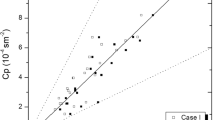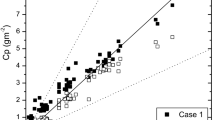Abstract
We present an analytical solution of the advection–diffusion equation of integer and fractional order applied to the dispersion of pollutants in the planetary boundary layer. The solution is obtained using the Laplace decomposition method, and the perturbation is obtained by homotopy, considering the Caputo derivative in the fractional case. To obtain the solution, two types of eddy diffusivities are used: in the integer-order equation, the eddy diffusivity is dependent on the longitudinal distance from the source (K\( \propto \)x and K\( \propto \)x2); in the fractional-order equation, the eddy diffusivity is constant. To validate the model, the results are compared with experimental data from the literature (Copenhagen and Prairie Grass). In the Copenhagen experiment, which was conducted under moderately unstable conditions, the best results are obtained under the influence of the memory effect with the eddy diffusivity dependent upon the source distance as K\( \propto \)x (with constant eddy diffusivity in the equation with a fractional derivative). However, in the strongly convective case of the Prairie Grass experiment, the best results are obtained only when the eddy diffusivity depends on the source distance as K\( \propto \)x2.







Similar content being viewed by others
References
Albani RAS, Duda FP, Pimentel LCG (2015) On the modeling of atmospheric pollutant dispersion during a diurnal cycle: a finite element study. Atmos Environ 118:19–27
Arya S (1995) Modeling and parameterization of near-source diffusion in weak winds. J Appl Meteorol 34(5):1112–1122
Barad ML (1958) Project Prairie-Grass: a field program in diffusion. Geophys Res. Air Force Cambridge Research Centre, USA, vol I and II (59)
Debnath L (2003) Recent applications of fractional calculus to science and engineering. Int J Math Math Sci 54:3413–3442
Degrazia GA, Velho HF, Carvalho JC (1997) Nonlocal Exchange coefficients for the convective boundary layer derived from spectral properties. Contrib Atmos Phys 70(1):57–64
Degrazia GA, Moreira DM, Vilhena MT (2001) Derivation of an eddy diffusivity depending on source distance for a vertically inhomogeneous turbulence in a convective boundary layer. J Appl Meteorol 40:1233–1240
Essa KSM, Etman SM, Embaby M (2007) New analytical solution of the dispersion equation. Atmos Res 84:337–344
Ganji DD, Rafei M (2006) Solitary wave solutions for a generalized Hirota-Satsuma coupled KdV equation by homotopy perturbation method. Phys Lett A 356(2):131–137
Ghorbani A (2009) Beyond Adomian polynomials: he polynomials. Chaos Soliton Frac 39(3):1486–1492
Goulart AGO, Lazo MJ, Suarez JMJ, Moreira DM (2017) Fractional derivative models for atmospheric dispersion of pollutants. Phys A 477:9–19
Gryning SE, Larsen SE (1984) Evaluation of a K-model formulated in terms of Monin–Obukhov similarity with the results from the Prairie Grass experiments. In: De Wispelaere C (ed) Air pollution modeling and its application III. Nato challenges of modern society (Energy engineering and advanced power systems), vol 5. Springer, Boston
Gryning SE, Lyck E (1984) Atmospheric dispersion from elevated sources in an urban area: comparison between tracer experiments and model calculations. J Clim Appl Meteorol 23(4):651–660
Gryning SE, Holtslag AMM, Irwin J, Sivertsen B (1987) Applied dispersion modelling based on meteorological scaling parameters. Atmos Environ 21(1):79–89
Hanna SR (1989) Confidence limit for air quality models as estimated by bootstrap and jacknife resampling methods. Atmos Environ 23(6):1385–1395
He JH (1999) Homotopy perturbation technique. Comput Methods Appl Mech Eng 178:257–262
He JH (2006) Recent development of the homotopy perturbation method. Topol Methods Nonlinear Anal 31(2):205–209
He JH (2009) An elementary introduction to the homotopy perturbation method. Comput Math Appl 57(3):410–412
Khan Y, Wu Q (2011) Homotopy perturbation transform method for nonlinear equations using He’s polynomials. Comput Math Appl 61:1963–1967
Kumar P, Sharan M (2010) An analytical model for dispersion of pollutants from a continuous source in the atmospheric boundary layer. Proc R Soc A 466:383–406
Moreira DM, Moret M (2018) A new direction in the atmospheric pollutant dispersion inside of the planetary boundary layer. J Appl Meteorol Clim 57(1):185–192
Moreira DM, Vilhena MT (2009) Air pollution and turbulence: modeling and applications. CRC Press, Boca Raton, p 354
Moreira DM, Carvalho JC, Degrazia GA, Vilhena MT, Moraes MR (2002) Dispersion parameterization applied to strong convection: low sources case. Hyb Meth Eng 4(1–2):89–107
Moreira DM, Rizza U, Vilhena MT, Goulart AG (2005a) Semi-analytical model for pollution dispersion in the Planetary Boundary Layer. Atmos Environ 39(14):2689–2697
Moreira DM, Vilhena MT, Tirabassi T, Buske D, Cotta RM (2005b) Near source atmospheric pollutant dispersion using the new GILTT method. Atmos Environ 39(34):6289–6294
Moreira DM, Vilhena MT, Buske D, Tirabassi T (2009) The state-of-art of the GILTT method to simulate pollutant dispersion in the atmosphere. Atmos Res 92(1):1–17
Moreira DM, Moraes AC, Goulart AG, Albuquerque TT (2014) A contribution to solve the atmospheric diffusion equation with eddy diffusivity depending on source distance. Atmos Environ 83:254–259
Nascimento ES, Moreira DM, Albuquerque TTA (2017) The development of a new model to simulate the dispersion of rocket exhaust clouds. Aerosp Sci Tech 69:298–312
Nascimento ES, Souza NBP, Kitagawa YKL, Moreira DM (2018) Simulated dispersion of the gas released by the SpaceX Falcon 9 rocket explosion. J Spacecr Rockets 55:1–9
Nieuwstadt FTM (1980) Application of mixed-layer similarity to the observed dispersion from a ground-level source. J Appl Meteorol 19(2):157–162
Nigmatullin RR (1986) The realization of the generalized transfer equation in a medium with fractal geometry. Phys Star Sol B 133:425–430
Pimentel LCG, Perez-Grerrero JS, Ulke AG, Duda FP, Heilbron Filho PFL (2014) Assessment of the unified analytical solution of the steady-state atmospheric diffusion equation for stable conditions. Proc R Soc A 470:20140021
Podlubny I (1999) Fractional differential equations. Academic Press, Cambridge, p 340
Rounds W (1955) Solutions of the two-dimensional diffusion equation. Am Geophys Union 36:395–405
Sharan M, Modani M (2006) A two-dimensional analytical model for the dispersion of air-pollutants in the atmosphere with a capping inversion. Atmos Environ 40(19):3479–3489
Sharan M, Singh MP, Yadav AK (1996) A mathematical model for the dispersion in low winds with eddy diffusivities as linear functions of downwind distance. Atmos Environ 30(7):1137–1145
Tirabassi T, Buske D, Moreira DM, Vilhena MT (2008) A two-dimensional solution of the advection–diffusion equation with dry deposition to the ground. J Appl Meteorol Climatol 47:2096–2104
Wang YX, Si HY, Mo LF (2008) Homotopy perturbation method for solving reaction-diffusion equations. Math Probl Eng. Article ID 795838
Weil J (1988) Dispersion in the convective boundary layer. In: Venkatram A, Wyngaard J (eds) Lectures on air pollution modeling. American Meteorological Society, Massachusetts, p 390
Wortmann S, Vilhena MT, Moreira DM, Buske D (2005) A new analytical approach to simulate the pollutant dispersion in the PBL. Atmos Environ 39(12):2171–2178
Yeh G, Huang C (1975) Three-dimensional air pollutant modelling in the lower atmosphere. Boundary-Layer Meteorol 9:381–390
Yildirim A, Kocak H (2009) Homotopy perturbation method for solving the space-time fractional advection–dispersion equation. Adv Water Resour 32(12):1711–1716
Acknowledgements
We thank CNPq and FAPESB for financial support.
Author information
Authors and Affiliations
Corresponding author
Appendix
Appendix
The Laplace transform of a fractional derivative, given by Caputo’s relation, is
where s is the transformed variable. Therefore, as used herein,
The Mittag–Leffler function is a generalization of the exponential function, first introduced as a one-parameter function by the series
and for more details, see Podlubny (1999).
Rights and permissions
About this article
Cite this article
Acioli, P.S., Xavier, F.A. & Moreira, D.M. Mathematical Model Using Fractional Derivatives Applied to the Dispersion of Pollutants in the Planetary Boundary Layer. Boundary-Layer Meteorol 170, 285–304 (2019). https://doi.org/10.1007/s10546-018-0403-1
Received:
Accepted:
Published:
Issue Date:
DOI: https://doi.org/10.1007/s10546-018-0403-1




